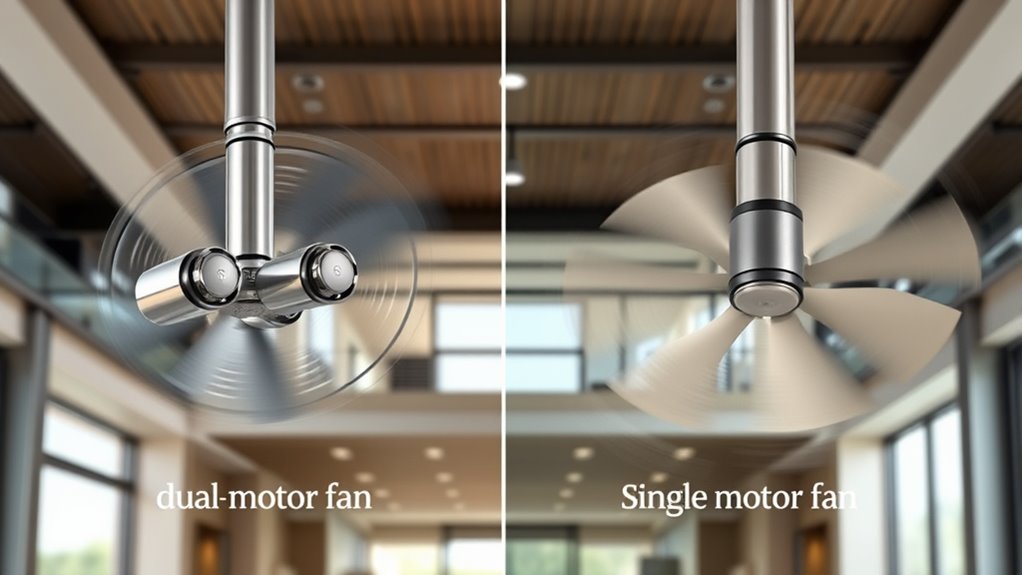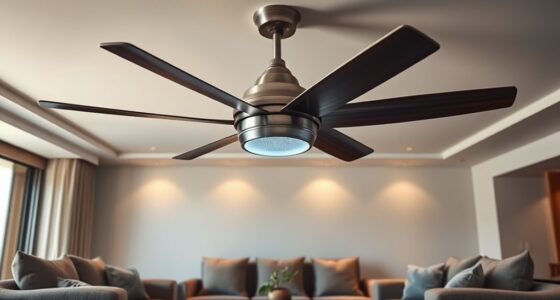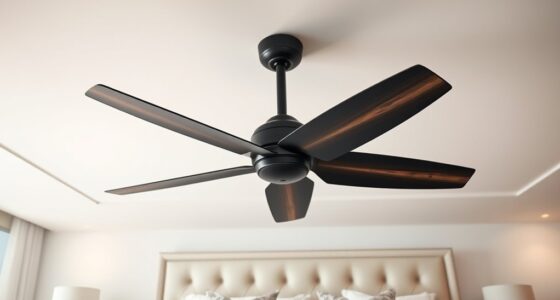Dual-motor fans provide better airflow coverage and more precise control than single-motor models, especially in large or complex spaces. With two motors, you can adjust airflow volume and direction more effectively, reducing hot spots and dead zones. They also operate more quietly and efficiently, making them ideal for expansive environments. If you want to discover how dual-motor fans outperform single-motor ones in various settings, you’ll find useful insights ahead.
Key Takeaways
- Dual-motor fans offer wider, more adaptable airflow coverage than single-motor models.
- They enable precise airflow direction and volume control for more even distribution.
- Dual-motor configurations reduce hot spots and dead zones in large or open spaces.
- Single-motor fans may struggle to effectively cover extensive areas, risking uneven airflow.
- Dual-motor fans deliver stronger, consistent airflow suitable for larger environments.
Understanding the Mechanics of Motor Configurations
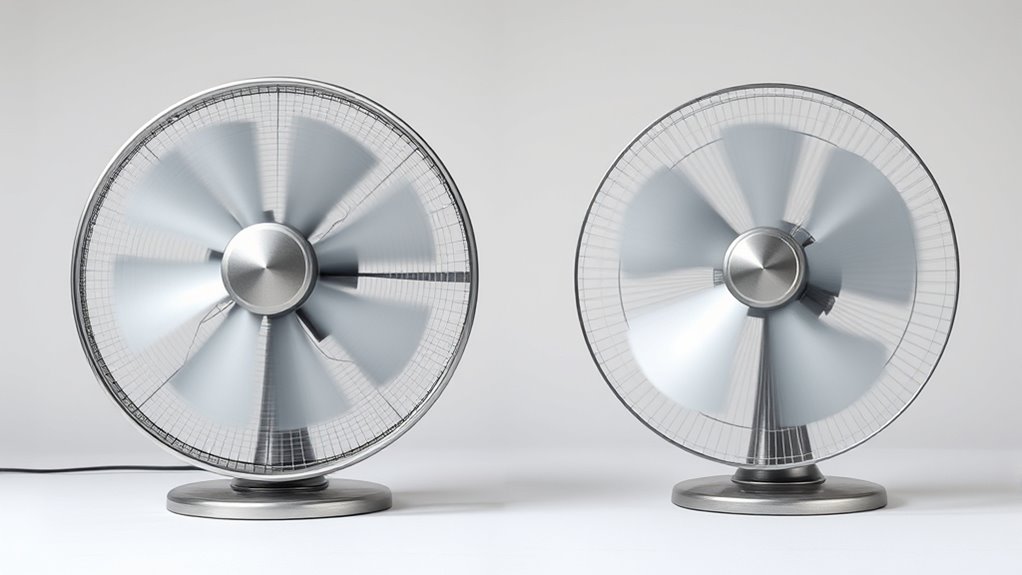
Understanding the mechanics of motor configurations is essential to grasp how dual-motor fans differ from single-motor fans. The key lies in blade design and motor placement. In single-motor fans, one motor powers all blades, often centrally located, which can limit airflow control. Dual-motor fans feature two separate motors, each with its own set of blades, allowing for more precise adjustments. Motor placement varies; some have motors positioned at opposite ends, while others place them side-by-side. This setup influences blade design, with blades tailored to optimize efficiency and airflow direction for each motor. Additionally, airflow control mechanisms differ significantly between the two configurations, impacting overall performance and user customization. By understanding how these configurations work, you can see how dual-motor fans offer enhanced flexibility and performance compared to traditional single-motor models. Moreover, motor efficiency plays a crucial role in energy consumption and noise levels, further differentiating these designs.
Airflow Range and Distribution Capabilities
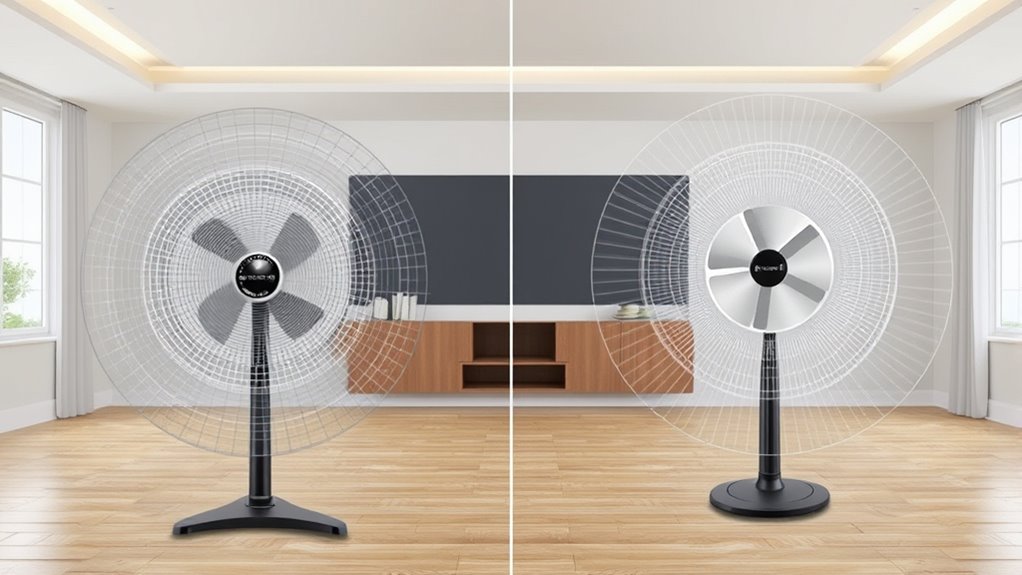
Dual-motor fans offer a wider and more adaptable airflow range compared to single-motor models. This flexibility enhances airflow consistency and coverage uniformity across various spaces. With dual motors, you can better control both the volume and direction of airflow, ensuring even distribution. This results in fewer hot spots and dead zones, making your environment more comfortable. To illustrate, consider the table below:
| Feature | Single-Motor Fans | Dual-Motor Fans | Advantage |
|---|---|---|---|
| Airflow Range | Narrow | Wide | Greater adaptability |
| Coverage Uniformity | Moderate | High | More consistent airflow |
| Airflow Control | Limited | Precise | Better coverage distribution |
This setup allows tailored airflow, improving overall performance and comfort. Additionally, incorporating multi-functionality like air ionization and UV light can further enhance air quality and comfort in your environment. Properly managing airflow dynamics is essential for optimizing air quality and reducing energy consumption across different spaces.
Performance in Large and Open Spaces
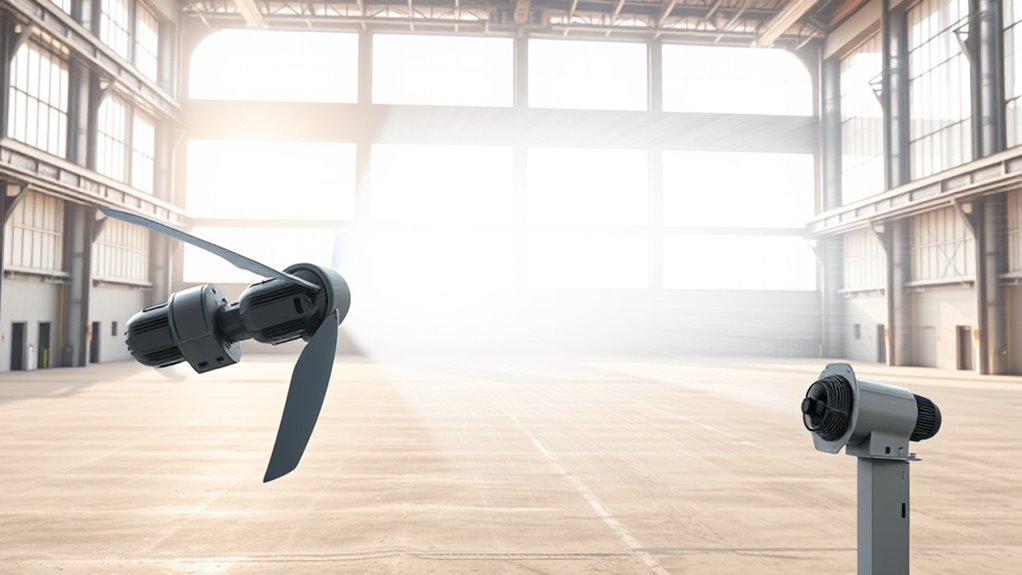
When it comes to large and open spaces, the ability to maintain consistent airflow becomes even more important. Dual-motor fans excel here by providing stronger, more even air distribution, ensuring every corner stays comfortable. Their robust design aesthetics often feature sleek, modern looks that blend seamlessly with large environments. Additionally, real-time monitoring capabilities of dual-motor systems enable proactive adjustments to airflow, enhancing overall comfort. These systems often incorporate advanced control features, which allow for precise customization of airflow patterns and intensity. Single-motor fans can struggle to cover expansive areas effectively, risking uneven airflow and hot spots. From a cost perspective, dual-motor systems may have higher initial investment but often reduce the need for additional units or adjustments. Conversely, single-motor fans tend to be more affordable upfront but might require multiple units to achieve the same coverage, increasing overall costs over time. For optimal performance, selecting the right fan type based on space size and airflow needs is essential. Your choice depends on balancing performance needs with design preferences and budget constraints.
Noise Levels and Energy Efficiency

You’ll notice that dual-motor fans often produce less noise than single-motor models, making them quieter in busy spaces. They also tend to consume more power, but their increased efficiency can offset energy costs over time. Considering these trade-offs helps you decide which fan type best balances noise reduction and energy savings for your needs. Additionally, understanding the developmental stages involved can help in selecting fans that are safer and more suitable for household environments. Being aware of local regulations can also influence your choice, ensuring compliance and safety in your area. Furthermore, the manufacturing quality of fans can impact both noise levels and energy efficiency, making it an important factor in your decision-making process.
Noise Reduction Benefits
While noise levels can vary depending on the design, dual-motor fans often operate more quietly than their single-motor counterparts. This is partly due to improved blade design, which helps reduce turbulence and air resistance, leading to less noise during operation. Additionally, dual-motor setups distribute workload more evenly, decreasing strain on each motor. This reduces vibrations and minimizes the likelihood of motor wear and tear, enhancing durability. Because each motor handles a smaller load, they can run at lower speeds while maintaining airflow, further decreasing noise emissions. Furthermore, sound insulation features in some dual-motor fans help to absorb residual noise, contributing to a quieter experience. The energy efficiency of dual-motor fans also plays a role in noise reduction, as more efficient motors generate less heat and operate smoother. Additionally, these fans often incorporate advanced motor technology that further minimizes operational noise. Overall, these design improvements contribute to a quieter environment, making dual-motor fans an excellent choice if noise reduction is a priority. You’ll benefit from a more peaceful space without sacrificing airflow performance.
Power Consumption Differences
Are dual-motor fans more energy-efficient than single-motor models? Not necessarily, but they often offer better power efficiency by distributing workload across two motors. This setup can lead to energy savings because each motor runs at lower capacity, reducing overall power consumption. With dual motors, you can also operate only the needed section, saving additional energy when full airflow isn’t required. Additionally, performance optimization depends on the design and quality of components, which influence actual energy use. Well-made dual-motor fans typically incorporate advanced motor technology, enabling more precise control and reduced energy waste. While dual-motor fans tend to consume less energy during excellent operation, they may still use more power if both motors run simultaneously at high speeds. Overall, they can provide energy-efficient airflow coverage, especially when adjustable settings allow for tailored operation.
Efficiency Trade-offs
Dual-motor fans often present a trade-off between noise levels and energy efficiency. While they can improve airflow coverage, they tend to generate more noise, affecting aesthetic appeal and comfort. Additionally, their complex design can increase cost implications, both initially and in maintenance. Consider these points:
- Higher noise levels may reduce user satisfaction but can be mitigated with sound-dampening features, especially if the fan is used in environments requiring quiet operation. Incorporating noise-reduction technology can help address this concern.
- Energy efficiency can vary, as dual motors sometimes consume more power, impacting operational costs, which is a crucial factor for large-scale implementations.
- The added motor complexity can increase the initial investment, though it might pay off with better airflow coverage. Proper design optimization can help balance performance and cost.
- Aesthetic appeal might suffer if noise or bulky design detracts from the visual environment.
- The materials used in dual-motor fans can influence durability and maintenance needs, impacting long-term performance and reliability. Using high-quality components can enhance longevity and reduce unforeseen repairs.
Installation and Maintenance Considerations
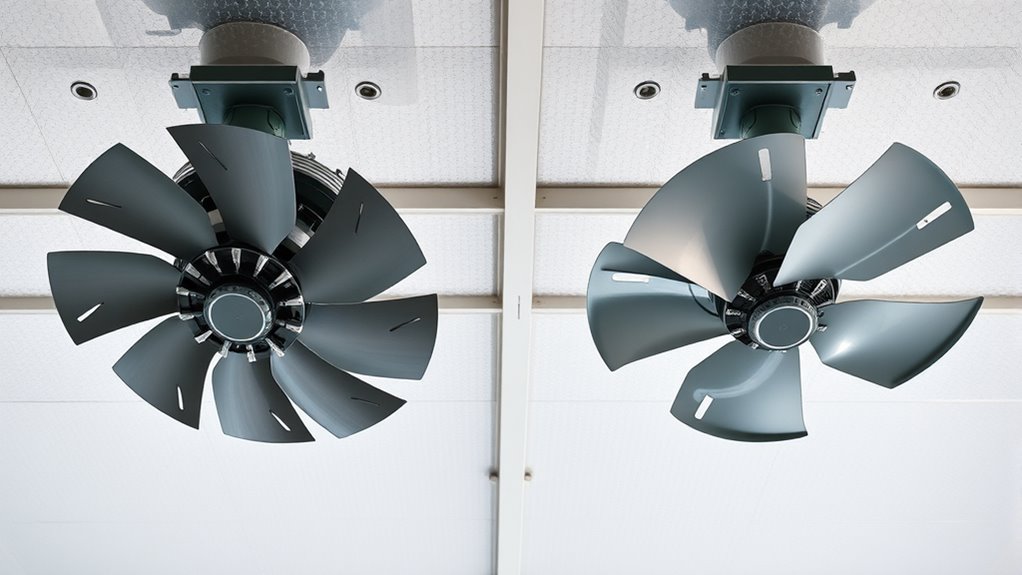
When installing dual-motor fans, you’ll find they often require more time and effort upfront due to their complexity. Maintenance access can be more challenging compared to single-motor models, which are typically simpler to service. Considering these factors helps guarantee smooth operation and easier upkeep over time. Additionally, selecting smart home automation options can streamline control and monitoring, making maintenance more manageable.
Ease of Installation
Installing dual-motor fans can be more complex than single-motor models due to their additional components, but many designs are now engineered for straightforward setup. You’ll find that modern dual-motor fans often feature simplified wiring and mounting options, making installation smoother. Keep in mind that:
- Proper alignment reduces motor noise and ensures quiet operation.
- Wiring complexity might increase, but clear instructions help streamline the process.
- Fan aesthetics matter; sleek designs can be easier to position and blend into your space.
- Ensuring secure mounting prevents vibrations, which can affect noise levels and appearance.
- Understanding installation science can help optimize the setup process and prolong the fan’s lifespan.
While dual-motor fans may initially seem more challenging to install, attention to these factors makes setup manageable and helps you enjoy the benefits without hassle.
Maintenance Accessibility
Maintaining dual-motor fans can be more involved than caring for single-motor models because of their additional components and complex wiring. You’ll need to regularly inspect both motors for signs of wear, ensuring their durability remains intact. Blade design plays a vital role here; accessible blades make cleaning and replacement easier, reducing downtime. With two motors, you’ll also need to check electrical connections and wiring more frequently to prevent malfunctions. The resilience of each motor influences maintenance needs—robust motors typically require less frequent servicing. Accessing components in dual-motor fans might be more challenging due to their size and configuration, so planning for proper clearance and easy access points is essential. Overall, while dual-motor fans demand more upkeep, thoughtful design can streamline maintenance tasks.
Practical Scenarios and Best Uses

Dual-motor fans excel in scenarios requiring high airflow and consistent performance, making them ideal for large spaces, industrial settings, and applications demanding robust cooling. They are especially suitable when a thorough cost analysis shows long-term savings through durability and efficiency. Additionally, their aesthetic appeal can complement modern designs, blending function with style. Consider these practical uses:
Dual-motor fans are ideal for large spaces, industrial use, and applications requiring durable, efficient cooling with modern aesthetics.
- Industrial warehouses needing uniform cooling and airflow coverage
- Large commercial spaces where consistent performance reduces downtime
- Data centers requiring reliable ventilation to prevent overheating
- Event venues or auditoriums where aesthetic appeal enhances interior design
In these situations, dual-motor fans provide the power and reliability needed, making them a smart investment despite potentially higher upfront costs.
Frequently Asked Questions
How Do Dual-Motor Fans Impact Overall Cost Compared to Single-Motor Fans?
When comparing costs, dual-motor fans tend to be more expensive upfront due to their complex design, but they often save you money over time through improved airflow and efficiency. Maintenance costs may be higher initially because of additional parts, yet their durability can lower long-term expenses. Overall, the cost comparison favors dual-motor fans if you prioritize better coverage and energy savings, despite a higher initial investment.
Can Dual-Motor Fans Be Configured for Variable Airflow Control?
Think of your fan setup as a symphony that you can conduct to match your needs. Yes, dual-motor fans can be configured for variable airflow, giving you precise control over how much air is circulated. By adjusting each motor independently, you customize fan configuration for maximum airflow, making your space comfortable and energy-efficient. This flexibility ensures you hit the right note in airflow management every time.
What Safety Features Are Typically Incorporated Into Dual-Motor Fan Systems?
You should look for safety features like safety sensor integration in dual-motor fan systems, which detect issues like overheating or obstructions. These systems often include emergency shutdown options, allowing you to quickly turn off the fan if needed. This guarantees safe operation, prevents damage, and protects users. With these safety features in place, you can operate your dual-motor fan confidently, knowing it has built-in safeguards for various emergency situations.
Are Dual-Motor Fans Suitable for Residential Use or Mainly Commercial?
You might think dual-motor fans are only for massive industrial spaces, but they’re surprisingly appropriate for residential use too! They deliver unparalleled airflow coverage, efficiently cooling large areas, though they can generate higher noise levels. If you’re after powerful, evenly distributed airflow and don’t mind a bit more sound, dual-motor fans can transform your home comfort. Just make certain your space can handle the noise, and you’ll enjoy their impressive performance daily.
How Does Fan Size Influence the Choice Between Dual and Single-Motor Configurations?
When choosing between dual and single-motor fans, you should consider fan size considerations and airflow distribution. Larger fans often benefit from dual-motor setups because they provide better airflow coverage across bigger spaces. Smaller fans typically work well with a single motor, offering sufficient airflow for compact areas. Your goal is to match the fan size to your space’s needs, ensuring efficient airflow distribution without unnecessary power consumption.
Conclusion
Choosing between dual-motor and single-motor fans is like selecting a compass for your journey—each guides airflow differently. Dual motors symbolize versatility, spreading comfort across vast horizons, while single motors represent focused precision. Your decision shapes the airflow landscape, sculpting the atmosphere with intention. By understanding their symbolism, you harness their true potential, turning your space into a sanctuary of balanced energy. Ultimately, it’s about aligning your needs with the right motor, steering your environment toward harmony.
